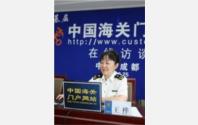 Online Interview
Online Interview
Topic: “QuanYuTong” Brings Steady Growth to Sichuan’s Foreign Trade
Time:10:00 AM (Wed) June 25, 2014
Special Guests:Ni Zao, Deputy Director General and Party Leadership Group Member of Chengdu Customs District
“QuanYuTong” Brings Steady Growth to Sichuan’s Foreign Trade
[Wang Hua]: Hello, netizens, welcome to China Customs Online Interview! I'm Wang Hua. The regional integration of customs clearance is one of the major reforms being pushed through by the GACC at present. Here with us today to talk about the regional clearance integration in Sichuan Province is Deputy Director General Ni Zao from Chengdu Customs District. Let's welcome Mr. Ni! 06/25/2014 9:59:40
[Ni Zao]: Hello everyone. I'm Ni Zao from Chengdu Customs District. I'm very happy to be here taking part in this discussion today. 06/25/2014 9:59:51
[Wang Hua]: Mr. Ni, China's regional customs clearance integration has received great interest from all sectors of society recently. It started in the Beijing-Tianjin-Hebei region, and now the GACC has announced that the Yangtze River Economic Zone will be undergoing similar reforms for the integration between Customs districts. Now you are currently creating a mode of "QuanYuTong", what does it mean? 06/25/2014 10:00:12
[Ni Zao]: "QuanYuTong" is the Chinese abbreviation for "customs clearance integration across Sichuan Province". This might sound a little abstract, but simply put, it means simplifying and integrating the clearance process and formalities for imported and exported goods, so as to achieve data sharing and seamless connections between major ports within Sichuan as well as between those in Sichuan and the rest of the country. 06/25/2014 10:00:39
[Ni Zao]: What makes it different from the cross-provinces and cross-customs-districts reforms in the Beijing-Tianjin-Hebei region, is that this will be mainly focused on Sichuan Province and the integration of customs offices within Chengdu Customs District. Of course, we are still looking to the Beijing-Tianjin-Hebei reform for useful practices, and we hope to be able to integrate into the regional customs clearance of Yangtze River Economic Zone as soon as possible so as to bring the benefits of integrated clearance to more Sichuan-based enterprises. 06/25/2014 10:01:35
[Wang Hua]: With simplification and integration of regional clearance, this "QuanYuTong" will make clearance much more convenient for enterprises. And how exactly do you plan to make things so convenient? 06/25/2014 10:02:00
[Ni Zao]: To be specific, in addition to the introduction of the GACC's "declaration at hometown, release at port" measures, Sichuan's "QuanYuTong" is currently implementing two new clearance models, i.e. the "Integration of Free Trade Zones and Ports" and "Multiple Declaration Points, Multiple Release Points", based on the most economical and rational import-export routes, to do away with traditional cross-customs transfer formalities employed within Chengdu Customs District, thus improving clearance efficiency with simplified procedures and reducing logistics costs. 06/25/2014 10:02:48
[Ni Zao]: After that, we will be working together with inspection and quarantine departments to provide the "Three Ones" service, achieving the integration of inspection and customs. 06/25/2014 10:03:09
[Wang Hua]: What does "Integration of Free Trade Zones and Ports" mean? Can you elaborate a little? 06/25/2014 10:03:55
[Ni Zao]: Let's look at the "Integration of Free Trade Zone and Port" model between Chengdu High Tech Comprehensive Bonded Zone and Chengdu Shuangliu Airport as an example. Under original clearance model, when imported goods arrived at Shuangliu Airport, enterprises in the Bonded Zone had to apply to the Airport Customs House for goods transfer to the Bonded Zone through examination and exterior inspection at the airport. When the goods arrived at the Bonded Zone, the enterprises would go through transfer completion formalities with the Bonded Zone Customs House and, after that, they could declare the import to the Bonded Zone Customs House for inspection and release. (The process is in reverse for exports).
Quick Links







